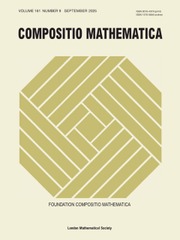As pointed out by O. Gabber, Lemma 8.3 in the above-cited paper was erroneous. The correct formulation of the lemma is given below. The proof of the new lemma can be derived from the same references given in the proof of loc. cit.
Let
![]() $(C_o, \vec {q}_o )$
be a
$(C_o, \vec {q}_o )$
be a
![]() $s$
-pointed
$s$
-pointed
![]() $\Gamma$
-curve such that
$\Gamma$
-curve such that
![]() $\Gamma$
acts stably on
$\Gamma$
acts stably on
![]() $C_o$
. Let
$C_o$
. Let
![]() $\tilde {C}_o$
be the normalization of
$\tilde {C}_o$
be the normalization of
![]() $C_o$
at the points
$C_o$
at the points
![]() $\Gamma \cdot r$
, where
$\Gamma \cdot r$
, where
![]() $r$
is a (stable) nodal point of
$r$
is a (stable) nodal point of
![]() $C_o$
. The nodal point
$C_o$
. The nodal point
![]() $r$
splits into two smooth points
$r$
splits into two smooth points
![]() $r',r''$
in
$r',r''$
in
![]() $\tilde {C}_o$
. Let
$\tilde {C}_o$
. Let
![]() $z'$
(respectively
$z'$
(respectively
![]() $z''$
) be a local parameter at
$z''$
) be a local parameter at
![]() $r'$
(respectively
$r'$
(respectively
![]() $r''$
) for the curve
$r''$
) for the curve
![]() $\tilde {C}_o$
. The following lemma shows that there exists a canonical smoothing deformation of
$\tilde {C}_o$
. The following lemma shows that there exists a canonical smoothing deformation of
![]() $(C_o, \vec {q}_o )$
over a formal disc
$(C_o, \vec {q}_o )$
over a formal disc
![]() $\mathbb {D}_\tau :=\textrm {Spec}\, \mathbb {C}[[\tau ]]$
. We denote by
$\mathbb {D}_\tau :=\textrm {Spec}\, \mathbb {C}[[\tau ]]$
. We denote by
![]() $\mathbb {D}^\times _\tau$
the associated punctured formal disc
$\mathbb {D}^\times _\tau$
the associated punctured formal disc
![]() $\textrm {Spec}\, \mathbb {C}((\tau ))$
.
$\textrm {Spec}\, \mathbb {C}((\tau ))$
.
Lemma 8.3. With the same notation as above, we assume that the stabilizer group
![]() $\Gamma _r$
at
$\Gamma _r$
at
![]() $r$
is cyclic and does not exchange the branches. Then, there exists a formal deformation
$r$
is cyclic and does not exchange the branches. Then, there exists a formal deformation
![]() $(C, \vec {q})$
of the
$(C, \vec {q})$
of the
![]() $s$
-pointed
$s$
-pointed
![]() $\Gamma$
-curve
$\Gamma$
-curve
![]() $(C_o, \vec {q}_o )$
over a formal disc
$(C_o, \vec {q}_o )$
over a formal disc
![]() $\mathbb {D}_\tau$
with the formal parameter
$\mathbb {D}_\tau$
with the formal parameter
![]() $\tau$
, such that the following properties hold:
$\tau$
, such that the following properties hold:
-
(1) over the closed point
 $o\in \mathbb {D}_\tau$
,
$o\in \mathbb {D}_\tau$
,
 $(C,\vec {q})|_{\tau =0}=(C_o,\vec {q}_o)$
;
$(C,\vec {q})|_{\tau =0}=(C_o,\vec {q}_o)$
; -
(2) over the punctured formal disc
 $\mathbb {D}^\times _\tau$
,
$\mathbb {D}^\times _\tau$
,
 $(C,\vec {q})|_{\mathbb {D}^\times _\tau }$
is a
$(C,\vec {q})|_{\mathbb {D}^\times _\tau }$
is a
 $s$
-pointed smooth projective curve over
$s$
-pointed smooth projective curve over
 $\mathbb {C}((\tau ))$
if
$\mathbb {C}((\tau ))$
if
 $\Gamma \cdot r$
are the only nodes in
$\Gamma \cdot r$
are the only nodes in
 $C_o$
;
$C_o$
; -
(3) the completed local ring
 $\hat {\mathscr {O}}_{C, r}$
of
$\hat {\mathscr {O}}_{C, r}$
of
 $\mathscr {O}_C$
at
$\mathscr {O}_C$
at
 $r$
is isomorphic to
$r$
is isomorphic to
 $\mathbb {C}[[z',z'', \tau ]]/\langle \tau - z'z''\rangle \simeq \mathbb {C}[[z',z'']]$
, where
$\mathbb {C}[[z',z'', \tau ]]/\langle \tau - z'z''\rangle \simeq \mathbb {C}[[z',z'']]$
, where
 $\Gamma _r$
acts on
$\Gamma _r$
acts on
 $z'$
(respectively
$z'$
(respectively
 $z''$
) via a primitive character
$z''$
) via a primitive character
 $\chi$
(respectively
$\chi$
(respectively
 $\chi ^{-1}$
); and
$\chi ^{-1}$
); and -
(4) there exists a
 $\Gamma$
-equivariant isomorphism of
$\Gamma$
-equivariant isomorphism of
 $\mathbb {C}[[\tau ]]$
-algebras(111)where
$\mathbb {C}[[\tau ]]$
-algebras(111)where \begin{equation} \kappa : \hat {\mathscr {O}}_{C\backslash \Gamma \cdot r,\, C_o \backslash \Gamma \cdot r }\simeq \mathscr {O}_{C_o\backslash \Gamma \cdot r}[[\tau ]], \end{equation}
\begin{equation} \kappa : \hat {\mathscr {O}}_{C\backslash \Gamma \cdot r,\, C_o \backslash \Gamma \cdot r }\simeq \mathscr {O}_{C_o\backslash \Gamma \cdot r}[[\tau ]], \end{equation}
 $ \hat {\mathscr {O}}_{C\backslash \Gamma \cdot r,\, C_o \backslash \Gamma \cdot r }$
is the completion of
$ \hat {\mathscr {O}}_{C\backslash \Gamma \cdot r,\, C_o \backslash \Gamma \cdot r }$
is the completion of
 ${\mathscr {O}}_{C\backslash \Gamma \cdot r}$
along
${\mathscr {O}}_{C\backslash \Gamma \cdot r}$
along
 $C_o \backslash \Gamma \cdot r$
.
$C_o \backslash \Gamma \cdot r$
.
-
– On page 2239, the lines 10–12 from the top should be replaced by the following.
Let
 $\theta ',\theta ''$
be the maps defined via Lemma 8.3 Part (3),where
$\theta ',\theta ''$
be the maps defined via Lemma 8.3 Part (3),where \begin{equation*} \theta ': \hat {\mathscr {O}}_{C, r} \to \mathbb {C}((z'))[[\tau ]], \text { and } \theta '': \hat {\mathscr {O}}_{C, r}\to \mathbb {C}((z''))[[\tau ]], \end{equation*}
\begin{equation*} \theta ': \hat {\mathscr {O}}_{C, r} \to \mathbb {C}((z'))[[\tau ]], \text { and } \theta '': \hat {\mathscr {O}}_{C, r}\to \mathbb {C}((z''))[[\tau ]], \end{equation*}
 $ \hat {\mathscr {O}}_{C, r}$
is the completion of
$ \hat {\mathscr {O}}_{C, r}$
is the completion of
 $ {\mathscr {O}}_{C}$
along
$ {\mathscr {O}}_{C}$
along
 $r$
.
$r$
.
-
– On page 2240, the lines 11–12 from the top should be replaced by the following.
Consider the following canonical homomorphisms (obtained by restrictions):
where \begin{equation*} \mathscr {O}_{{C}\backslash \Gamma \cdot \vec {q}}\to \mathscr {O}_{C\backslash \Gamma \cdot (\vec {q} \cup \{r\} )} \to \hat {\mathscr {O}}_{C\backslash \Gamma \cdot (\vec {q}\cup \{r\}), C_o\backslash \Gamma \cdot (\vec {q}_o\cup \{r\}) }\overset {\kappa '}{\cong } \mathscr {O}_{C_o\backslash \Gamma \cdot (\vec {q}_o\cup \{r\}) }[[\tau ]], \end{equation*}
\begin{equation*} \mathscr {O}_{{C}\backslash \Gamma \cdot \vec {q}}\to \mathscr {O}_{C\backslash \Gamma \cdot (\vec {q} \cup \{r\} )} \to \hat {\mathscr {O}}_{C\backslash \Gamma \cdot (\vec {q}\cup \{r\}), C_o\backslash \Gamma \cdot (\vec {q}_o\cup \{r\}) }\overset {\kappa '}{\cong } \mathscr {O}_{C_o\backslash \Gamma \cdot (\vec {q}_o\cup \{r\}) }[[\tau ]], \end{equation*}
 $ \kappa^{\prime}$
is obtained from
$ \kappa^{\prime}$
is obtained from
 $ \kappa$
via restriction.
$ \kappa$
via restriction.


